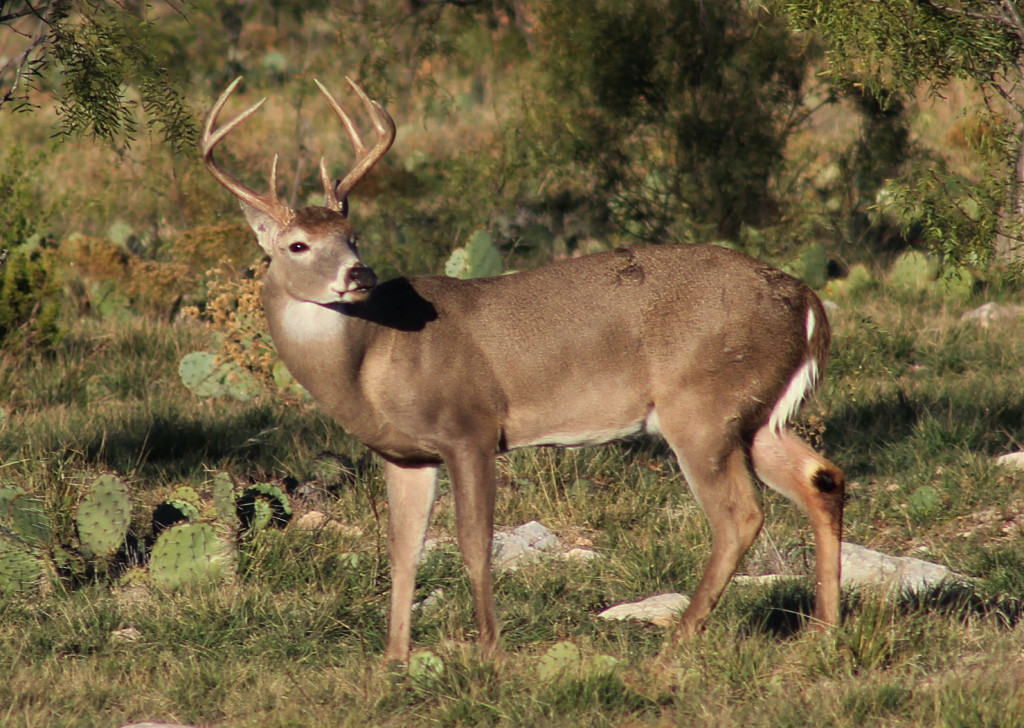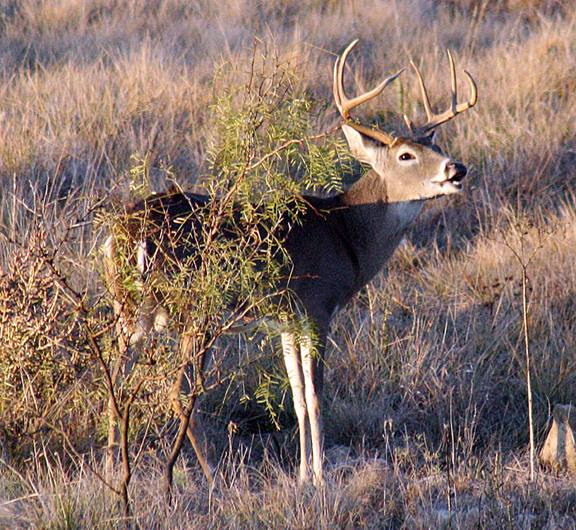Chronic wasting disease is not prevalent in Texas, having only been discovered in the remote far western reaches of El Paso and Hudspeth counties, but as with other safety issues, deer hunters again are urged this fall and winter to take precautions to help curb the possibility of outbreaks that have ravaged populations in other states.
In 2012 tissue samples from a pair of mule deer killed in the Hueco Mountains near the New Mexico border returned positive results for the disease, effectively lumping the state in with 20 others where the disease has been discovered.
It’s a red flag for sure, which is why Texas Parks & Wildlife Department officials and biologists again are asking for hunter participation in mule deer check stations for those who successfully harvest animal, but there’s no overriding reason for alarm. New Mexico is among the states where the disease has been confirmed, and the remote mountains that spill over into our neighbors to the west have harbored animals with CWD for some time.
However, deer aren’t the real danger in connection with CWD. The real threat remains the unscrupulous individual attempting to make big bucks by illegally smuggling deer that pose the greatest threat to our native population pegged at more than 4 million.
For that reason, TPWD, in conjunction with the Texas Animal Health Commission and other state and national entities, has developed a surveillance plan and protocols aimed at discovering and containing further transmission among the state’s deer herds, which remain a multi-billion dollar industry. TPWD estimates more than a half-million hunters on average annually have pursued deer during seasons in the past decade, and deer hunting’s direct economic impact is more than $2 billion annually in Texas. Deer breeding activities alone represent a $650 million industry, according to TPWD.
The TAHC has authority for reporting and tracking diseases in alternative livestock including elk, red deer and sika deer, and TPWD has authority over free-ranging white-tailed and mule deer. The agencies also share regulatory authority over captive deer held under the authority of breeder permits.
Texas shut down the importation of deer from other states a decade ago and has conducted a rigorous CWD testing program ever since. TPWD has received test results indicating no disease detection for more than 25,000 samples collected from wild deer around the state since the 2002-03 hunting season, according to agency figures. Most were collected from hunter-harvested deer.
More than 7,000 similar results were submitted from permitted deer breeders.
TPWD also has established strict requirements on the movement of whitetails and muleys from breeder facilities. They include meeting certification status conditions with the TAHC, Texas Veterinary Medical Diagnostic Laboratories and the agency itself. Penalties include losing qualified status to move animals for a year or more, which can hit breeders in the pocket book.

The Disease
CWD is a fatal transmissible neurological disease in the family of infectious diseases that include bovine spongiform encephalopathy, commonly known as “mad cow disease,” scrapie in sheep, feline spongiform encephalopathy in cats in Europe, and Creutzfeldt-Jakob disease and a new variant in humans. CWD is believed to be caused by a misfolded protein that replicates and infects normal proteins, according to researchers. CWD is named for its symptoms, including appetite loss, weight loss, listlessness, excessive drooling, blank stares, decreased awareness and behavioral changes. The diagnosis of the disease can’t be made by symptoms since other toxic and neurological afflictions can cause an animal to exhibit similar symptoms, according to researchers.
CWD originally was discovered in captive Colorado animals 35 years ago. However, during the past five years the disease has been detected in free-ranging deer and elk in several surrounding states and Canada. In 2002, a year after Texas closed its borders to importation of deer due to disease risks, CWD was reported in free-ranging deer in South Dakota, Wisconsin, New Mexico, Illinois and Utah.
CWD, which has no known immunity or treatment, occurs via natural transmission in deer, elk and moose. However, research indicates that infection of livestock through natural pathways is unlikely. It should be noted that the disease has not shown the ability to jump the species barrier to humans, according to researchers.
CWD has been shown to affect the brain, spinal cord and other lymph areas of infected animals, but proper field dressing typically removes any of these sites and hunters are advised to also bone out their meat. If you take animals to be processed commercially, ask that the meat be handled separately from that of others, too. If you suspect an animal you harvest has some type of disease, wildlife officials urge you to keep the carcass refrigerated or on ice and contact biologists, and certainly don’t attempt to eat any of the meat.
One troubling aspect of CWD is proof that it can spread, remain dormant for years and still affect natural resources, according to researchers. Case in point: a shipment of elk from an infected herd in Canada to South Korea in 1997 went undetected for nearly 10 years. Despite tracing back the imported animals, which were euthanized for testing in 2005, CWD persists in that country, TPWD officials said. The disease previously had been found only in Canada and the U.S.
Eradication of the disease increasingly is expected to become less attainable if it spreads through more populations, according to researchers. That makes a surveillance plan critical to the earliest detection followed with an adequate response plan.
TPWD previously regulated the importation of white-tailed deer and mule deer through its scientific breeder permit program. TAHC entry requirements were incorporated into the permit program and deer imported from other states must have originated from herds enrolled in an official CWD monitoring program for at least three years. In states where the disease was detected, the required monitoring period was extended to five years. Those frameworks still exist for the importation of other cervids including elk, red deer and sika deer.
The Threat
The recent conviction of a former South Texas deer breeder underscores just how far some are willing to go to cash in on deer in the Lone Star State, which is most troubling aspect of the industry for biologists and law enforcement officials.
Frank Thomas Shumate Jr., 51, and Kalub Rogers, 31, of Corpus Christi, each were assessed $14,127.50 in fines and agreed to surrender the ability to apply for a deer breeder permit or a hunting lease license after pleading guilty to 50 charges of unlawful possession and/or sale of live game animals. The couple also agreed to surrender hunting licenses through the end of the 2015 license year and 2017 license year, respectively.
An investigation into Shumate’s deer breeding activities began in March 2004 and led to multiple charges in three counties, according to a TPWD news release. In 2006 his deer breeder violations resulted in 10 convictions on criminal charges in Jim Wells County and five convictions each in Nueces County and Webb County. Shumate agreed to relinquish his scientific breeder’s permit and all deer held in captivity in his deer breeding facility in Nueces County.
Before losing his deer breeding privileges, Shumate initiated a plan to have a new deer breeding facility permitted in the name of Rogers on his property in Karnes County, where he then transferred more than 100 deer from his Nueces County facility, according to the release. TPWD’s Special Operations Unit also received numerous reports that Shumate remained active in the deer business and was buying and selling deer for which he was not legally authorized.
Further investigation revealed that Shumate conducted sales of at least 78 white-tailed deer from Rogers’ deer breeding facility to ranches for release into the wild for stocking purposes since September 2010, according to the release. Shumate received at least $171,466 for deer he illegally sold, which according to records submitted to TPWD, were transported from Rogers’ facility. The probe also indicated that Rogers held a deer breeder permit in her name on behalf of her husband, Shumate.
Rogers’ facility came under additional scrutiny in 2012 as a result of a delinquent annual report required of permitted deer breeding facilities. Criminal charges were filed when a herd inspection and inventory revealed irregularities and discrepancies, including 162 inventoried deer that were missing, according to the release. During a herd inspection TPWD wildlife biologists noted the remaining deer in the facility to be in poor condition and multiple decayed carcasses were observed throughout the pens.
The observation of 142 deer of unknown origin was cause for additional concern and tissue samples from several deer were tested for chronic wasting disease and bovine tuberculosis. While neither disease was detected, the illegal actions highlight the biggest threat to Texas’ native deer herds.
“Unscrupulous actions by these two individuals are not only a threat to all the law-abiding deer breeders who are carefully monitoring and managing their facilities, but also to the state’s free-ranging deer, which can be exposed to unnecessary disease risk from these illegitimate activities,” said Mitch Lockwood, TPWD’s Big Game Program Director, in the release. “Captive and free-ranging deer are too important to our state to have them compromised by the actions of a few.”
Information: Texas Parks & Wildlife.




















